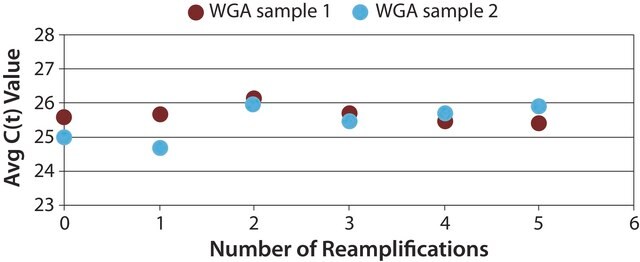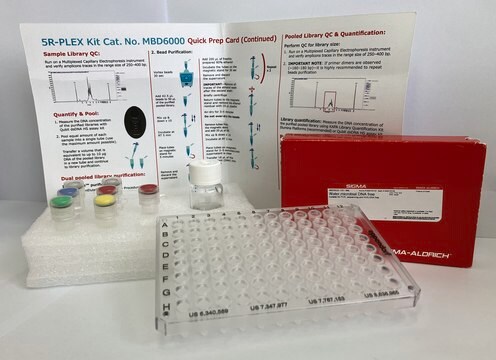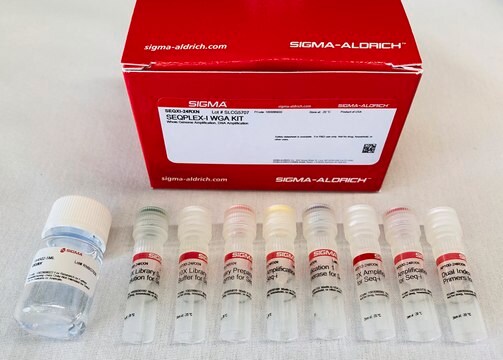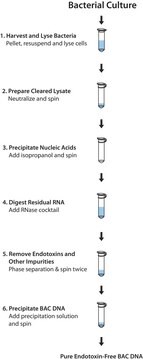推薦產品
一般說明
應用
- 芯片分析
- SNP分析
- STR分析
- DNA存档
特點和優勢
- 以最少的模板获得更高的产量: 在不到 3 小时内将纳克量的基因组 DNA 扩增为微克产量(约 10μ g)
- 纳克样品可在 –20 °C 下保存以备将来使用
- 可选择各种DNA来源:全血、口腔拭子、血卡、植物、土壤、&福尔马林固定石蜡包埋的组织(FFPE)
- 全基因组扩增 (WGA) DNA 聚合酶提高扩增准确度
- 全基因组无可检出的等位基因偏倚
- 兼容许多下游应用,例如 TaqMan ®检测、单核苷酸多态性 (SNP) 分析、比较基因组杂交 (CGH) 分析
其他說明
法律資訊
訊號詞
Danger
危險聲明
危險分類
Resp. Sens. 1
儲存類別代碼
12 - Non Combustible Liquids
閃點(°F)
Not applicable
閃點(°C)
Not applicable
分析證明 (COA)
輸入產品批次/批號來搜索 分析證明 (COA)。在產品’s標籤上找到批次和批號,寫有 ‘Lot’或‘Batch’.。
客戶也查看了
文章
In recent years, array-based Comparative Genomic Hybridization (aCGH) has been refined to determine chromosomal changes at progressively higher resolutions. This evolving technology is, however, somewhat hampered by the large DNA input requirement—a minimum of 150,000 copies of a human genome, or 0.5 μg, are generally needed per sample to process one CGH array.
In recent years, array-based Comparative Genomic Hybridization (aCGH) has been refined to determine chromosomal changes at progressively higher resolutions. This evolving technology is, however, hampered by the large DNA input requirement—a minimum of 150,000 copies of a human genome, or 0.5 μg, are generally needed per sample to rocess one CGH array.
The assessment of DNA quality is a crucial first step in acquiring meaningful data from formalin-fixed paraffin-embedded (FFPE) tissues, and other sources of damaged DNA. Using intact genomic DNA is key for successful analysis of chromosomal aberrations (e.g. SNP analysis, LOH, aCGH, etc.).
條款
Genomic DNA from soil samples can be easily damaged by nucleases and contaminating debris resulting in low DNA yields. As a result, the researcher’s ability to perform downstream analysis may be compromised. After isolating DNA from the soil sample, the GenomePlex® Whole Genome Amplification Protocol is followed
Whole genome amplification (WGA) of plasma and serum DNA presents a unique challenge due to the small amount of nucleic acid in such samples.
This protocol provides a simple and convenient method to isolate, amplify and purify genomic DNA from saliva
Whole blood is a common source of material used to perform genetic analysis. Many times genomic DNA isolated from whole blood samples is of low yield. This protocol is a simple method to isolate DNA from fresh or aged whole blood products. Once the DNA is isolated, it can be amplified using the GenomePlex® Whole Genome Amplification protocol.
相關內容
GenomePlex® Whole Genome Amplification is the method of extracting DNA from the animal sample. GenomePlex® products have been used to amplify genomic DNA from chicken, porcine, bovine, fish, and shrimp source.
GenomePlex® Whole Genome Amplification is the method of extracting DNA from the animal sample. GenomePlex® products have been used to amplify genomic DNA from chicken, porcine, bovine, fish, and shrimp source.
我們的科學家團隊在所有研究領域都有豐富的經驗,包括生命科學、材料科學、化學合成、色譜、分析等.
聯絡技術服務













